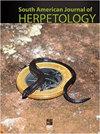MalvasáRocket Frog,Hyloxalus pinguis的分布更新、广告呼吁和系统发育位置(Anura:Dendrobatidae)
IF 0.7
4区 生物学
Q4 ZOOLOGY
引用次数: 0
摘要
摘要Malvasá火箭蛙Hyloxalus pinguis是一种研究较少的物种,分布有限,自然历史数据有限。它的分类地位也不确定,一些研究人员认为它是H.pulchellus的初级异名。我们探索了平尾鹬与该属其他物种之间的差异,更新了它的分布,包括两个新的位置,描述了它的发声,并提供了生命中第一批遗传数据和图像。该物种仅在哥伦比亚西南部海拔2930–3205米的安第斯山脉高生态系统中的受干扰地区已知。所有新的地区都靠近小溪和湿地。发声包括一长串单个音符,每次呼叫有2-13个音符,每分钟有42-43个音符,主频为3488-4048 Hz,这与该属的相关物种不同。线粒体数据表明,平尾蛇是德拉托雷蛇的姐妹,而不是之前怀疑的普尔切罗蛇分支的一部分。两个被描述为H.pulchellus的标本与主要的H.pulchelrus分支分开放置,需要进行分类学修订,其中包括一个来自Monte Olivo(厄瓜多尔)的标本,该标本与H.pinguis分组,但差异很大(16S的未校正成对距离为3.9%)。这可能是平鼻蛛的一个不同的线粒体谱系,其范围将大大扩展到南方,也可能是一个未描述的分类单元,需要进一步研究。总的来说,线粒体系统发育重建、遗传距离和不同的发声叫声表明,扁尾蛇是一个有效的物种,而不是羊肚菌的初级异名,其已知的小分布使其成为优先保护物种。需要对Hyloxalus进行进一步的系统研究,包括收集核遗传数据,以充分了解这个研究不足的属,它可能具有额外的未描述的多样性。本文章由计算机程序翻译,如有差异,请以英文原文为准。
Distribution Update, Advertisement Call, and Phylogenetic Position of the Malvasá Rocket Frog, Hyloxalus pinguis (Anura: Dendrobatidae)
Abstract. The Malvasá rocket frog, Hyloxalus pinguis, is a poorly studied species with a restricted distribution and limited data on its natural history. Its taxonomic status is also uncertain, with some researchers considering it to be a junior synonym of H. pulchellus. We explore the differences between H. pinguis and other species within the genus, update its distribution, including two new localities, describe its vocalizations, and provide the first genetic data and images in life. The species is known exclusively from disturbed areas within high Andean ecosystems in southwestern Colombia at 2,930–3,205 m above sea level (a.s.l.). All new localities were close to small creeks and wetlands. The vocalizations comprise a long train of single notes with 2–13 notes per call, 42–43 notes per minute, and a dominant frequency of 3,488–4,048 Hz, which differs from related species in the genus. Mitochondrial data suggest that H. pinguis is sister to H. delatorreae and not part of the H. pulchellus clade as previously suspected. Two specimens described as H. pulchellus are placed separately from the main H. pulchellus clade and require taxonomic revision, including a specimen from Monte Olivo (Ecuador) that groups with H. pinguis but is highly divergent (uncorrected pairwise distance of 3.9% for 16S). This could either be a divergent mitochondrial lineage of H. pinguis that would extend its range substantially to the south or be an undescribed taxon in need of further study. Overall, the mitochondrial phylogenetic reconstructions, genetic distances, and distinct vocalization calls suggest that H. pinguis is a valid species and not a junior synonym of H. pulchellus, and its small known distribution make it a conservation priority. Further systematic research on Hyloxalus is needed, including the collection of nuclear genetic data, to fully understand this understudied genus that likely harbors additional undescribed diversity.
求助全文
通过发布文献求助,成功后即可免费获取论文全文。
去求助
来源期刊
CiteScore
1.50
自引率
0.00%
发文量
10
期刊介绍:
The South American Journal of Herpetology (SAJH) is an international journal published by the Brazilian Society of Herpetology that aims to provide an effective medium of communication for the international herpetological community. SAJH publishes peer-reviewed original contributions on all subjects related to the biology of amphibians and reptiles, including descriptive, comparative, inferential, and experimental studies and taxa from anywhere in the world, as well as theoretical studies that explore principles and methods.

 求助内容:
求助内容: 应助结果提醒方式:
应助结果提醒方式:


